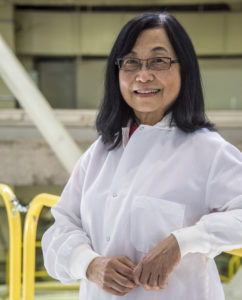The Gordon and Betty Moore Foundation is supporting the development of a unique microscopy concept pioneered by researchers at Berkeley Lab as part of the Foundation’s Symbiosis in Aquatic Systems Initiative (SASI). The Berkeley Lab effort has received $500,000 and will be led by senior staff scientist Hoi-Ying Holman of the Molecular Biophysics and Integrated Bioimaging (MBIB) Division. Stefano Cabrini, director of Nanofabrication at the Molecular Foundry, and Hans Bechtel, an infrared beamline scientist at the Advanced Light Source (ALS), are co-lead investigators on the project.
 Holman, who also directs the Berkeley Synchrotron Infrared Structural Biology Imaging Program (BSISB), currently uses the broadband synchrotron infrared beam (SIR) at the ALS to study microscale chemical activities in microbial communities. The proposed new technique combines SIR with a new near-field scanning optical microscopy (NSOM) technique. Holman and her colleagues believe the combination of techniques will advance the current boundaries of nanoscale infrared imaging by making more efficient use of the synchrotron infrared-rays and substantially increasing the signal to noise ratio. It will also increase the diversity of the symbiosis model systems that can be studied.
Holman, who also directs the Berkeley Synchrotron Infrared Structural Biology Imaging Program (BSISB), currently uses the broadband synchrotron infrared beam (SIR) at the ALS to study microscale chemical activities in microbial communities. The proposed new technique combines SIR with a new near-field scanning optical microscopy (NSOM) technique. Holman and her colleagues believe the combination of techniques will advance the current boundaries of nanoscale infrared imaging by making more efficient use of the synchrotron infrared-rays and substantially increasing the signal to noise ratio. It will also increase the diversity of the symbiosis model systems that can be studied.
Investigating microbe-microbe symbiotic interactions will provide insights into the evolution of aquatic microbes – the first forms of life on Earth – and improve the scientific community’s understanding of aquatic ecosystem dynamics, such as nutrient cycling and carbon sequestration. These processes are the basis of global food chains and climate processes.
Read more in the Berkeley Lab News Center.



